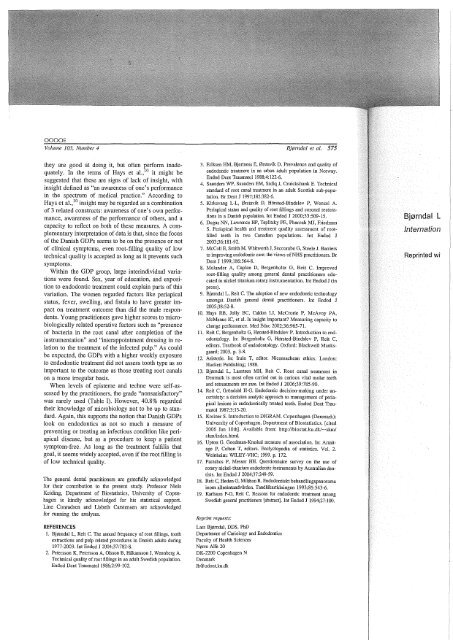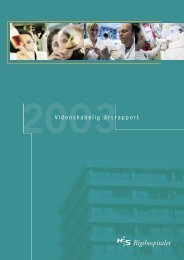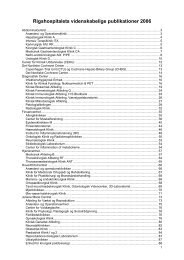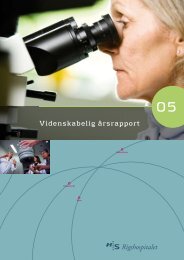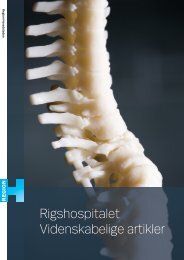View - CTU
View - CTU
View - CTU
You also want an ePaper? Increase the reach of your titles
YUMPU automatically turns print PDFs into web optimized ePapers that Google loves.
OOOOE<br />
Volume 103, Number 4<br />
Bj¢mdal et al. 575<br />
they are good at doing it, but often perform inadequately.<br />
In the terms of Hays et al., 10 it might be<br />
suggested that these are signs of lack of insight, with<br />
insight defined as "an awareness of one's performance<br />
in the spectrum of medical practice." According to<br />
Hays et al., 10 insight may be regarded as a combination<br />
of 3 related constructs: awareness of one's own performance,<br />
awareness of the performance of others, and a<br />
capacity to reflect on both of these measures. A complementary<br />
interpretation of data is that, since the focus<br />
of the Danish GDPs seems to be on the presence or not<br />
of clinical symptoms, even root-filling quality of low<br />
technical quality is accepted as long as it prevents such<br />
symptoms.<br />
Within the GDP group, large interindividual variations<br />
were found. Sex, year of education, and exposition<br />
to endodontic treatment could explain parts of this<br />
variation. The women regarded factors like periapical<br />
status, fever, swelling, and fistula to have greater impact<br />
on treatment outcome than did the male respondents.<br />
Young practitioners gave higher scores to microbiologically<br />
related operative factors such as "presence<br />
of bacteria in the root canal after completion of the<br />
instrumentation" and "interappointment dressing in relation<br />
to the treatment of the infected pulp." As could<br />
be expected, the GDPs with a higher weekly exposure<br />
to endodontic treatment did not assess tooth type as so<br />
important to the outcome as those treating root canals<br />
on a more irregular basis.<br />
When levels of episteme and techne were self-assessed<br />
by the practitioners, the grade "nonsatisfactory"<br />
was rarely used (Table I). However, 40.8% regarded<br />
their knowledge of microbiology not to be up to standard.<br />
Again, this supports the notion that Danish GDPs<br />
look on endodontics as not so much a measure of<br />
preventing or treating an infectious condition like pe1iapical<br />
disease, but as a procedure to keep a patient<br />
symptom-free. As long as the treatment fulfills that<br />
goal, it seems widely accepted, even if the root filling is<br />
of low technical quality.<br />
The general dental practitioners are gratefully acknowledged<br />
for their contribution to the present study. Professor Niels<br />
Keiding, Department of Biostatistics, University of Copenhagen<br />
is kindly acknowledged for his statistical support.<br />
Line Conradsen and Lisbeth Carstensen are acknowledged<br />
for running the analyses.<br />
REFERENCES<br />
I. Bj¢mdal L, Reit C. The annual frequency of root fillings, tooth<br />
extractions and pulp related procedures in Danish adults during<br />
1977-2003. Int Endod J 2004;37:782-8.<br />
2. Petersson K, Petersson A, Olsson B, Hi\kansson J, Wennberg A.<br />
Technical quality of root fillings in an adult Swedish population.<br />
Endod Dent Traumatol 1986;2:99-102.<br />
3. Eriksen HM, Bjertness E, 0rstavik D. Prevalence and quality of<br />
endodontic treatment in an urban adult population in Norway.<br />
Endod Dent Traumatol 1988;4: 122-6.<br />
4. Saunders WP, Saunders EM, Sadiq J, Cruickshank E. Technical<br />
standard of root canal treatment in an adult Scottish sub-population.<br />
Br Dent J 1997;182:382-6.<br />
5. Kirkevang L-L, 0rstavik D, Horsted-Bindslev P, Wenzel A.<br />
Periapical status and quality of root fillings and coronal restorations<br />
in a Danish population. Int Endod J 2000;33:509-15.<br />
6. Dugas NN, Lawrence HP, Teplitsky PE, Pharoah MJ, Friedman<br />
S. Periapical health and treatment quality assessment of rootfilled<br />
teeth in two Canadian populations. Int Endod J<br />
2003;36:181-92.<br />
7. McColl E, Smith M, Whitworth J, Seccombe G, Steele J. Barriers<br />
to improving endodontic care: the views of NHS practitioners. Br<br />
Dent J 1999;186:564-8.<br />
8. Molander A, Caplan D, Bergenholtz G, Reit C. Improved<br />
root-filling quality among general dental practitioners educated<br />
in nickel titanium rotary instrumentation. Int Endod J (in<br />
press).<br />
9. Bj¢mdal L, Reit C. The adoption of new endodontic technology<br />
amongst Danish general dental practitioners. Int Endod J<br />
2005;38:52-8.<br />
10. Hays RB, Jolly BC, Caldon LJ, McCrorie P, McAvoy PA,<br />
McManus IC, et al. Is insight important? Measuring capacity to<br />
change performance. Med Educ 2002;36:965-71.<br />
11. Reit C, Bergenholtz G, H¢rsted-Bindslev P. Introduction to endodontology.<br />
In: Bergenholtz G, H¢rsted-Bindslev P, Reit C,<br />
editors. Textbook of endodontology. Oxford: Blackwell Munksgaard;<br />
2003. p. 3-8.<br />
12. Aristotle. In: !ruin T, editor. Nicomachean ethics. London:<br />
Hackett Publishing; 1988.<br />
13. Bj¢mdal L, Laustsen MH, Reit C. Root canal treatment in<br />
Denmark is most often carried out in carious vital molar teeth<br />
and retreatments are rare. Int Endod J 2006;39:785-90.<br />
14. Reit C, Grondahl H-G. Endodontic decision-making under uncertalnty:<br />
a decision analytic approach to management of periapical<br />
lesions in eadodontically treated teeth. Endod Dent Traumatol<br />
1987;3:15-20.<br />
15. Kreiner S. Introduction to DIGRAM. Copenhagen (Denmark):<br />
University of Copenhagen, Department of Biostatistics. [cited<br />
2006 Jan 10th]. Available from: http://biostat.ku.dk/-slan/<br />
skm/index.html.<br />
16. Upton G. Goodman-Kruskal measure of association. In: Armitage<br />
P, Colton T, editors. Enclyclopedia of statistics. Vol. 2.<br />
Weinheim: WILEY-VHC; 1999. p. 172.<br />
17. Parashos P, Messer HH. Questionnaire survey on the use of<br />
rotary nickel-titanium endodoatic instruments by Australian dentists.<br />
Int Endod J 2004;37:249-59.<br />
18. Reit C, Heden G, Milthon R. Endodoatiskt behandlingspanorama<br />
inom allmantandvilrden. Tandliikartidningen 1993;85:543-6.<br />
19. Karlsson P-0, Reit C. Reasons for endodoatic treatment among<br />
Swedish general practitioners [abstract]. Int Endod J 1994;27:100.<br />
Reprint requests:<br />
Lars Bj¢mdal, DDS, PhD<br />
Department of Cariology and Endodontics<br />
Faculty of Health Sciences<br />
N¢rre Alie 20<br />
DK-2200 Copenhagen N<br />
Denmark<br />
lb@odont.ku.dk<br />
Bj0rndal L<br />
Internation<br />
Reprinted wi


